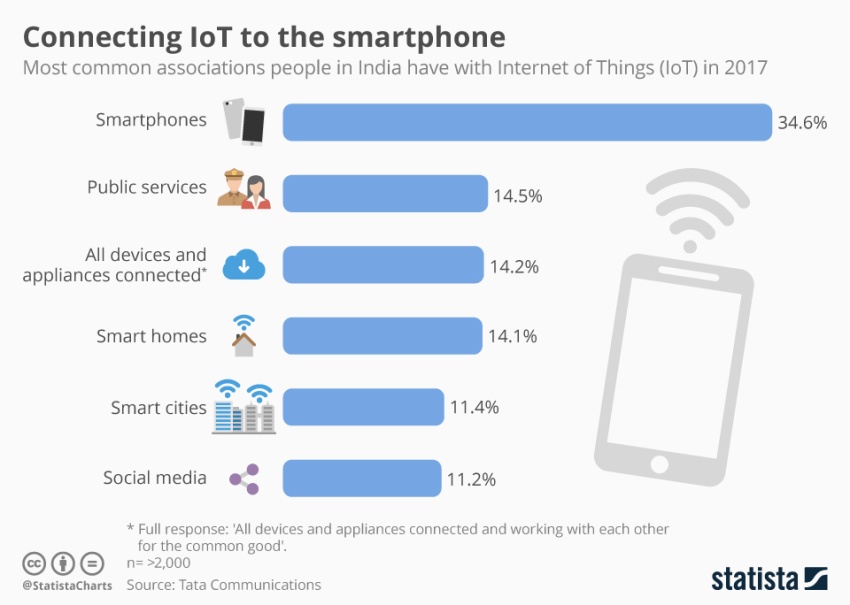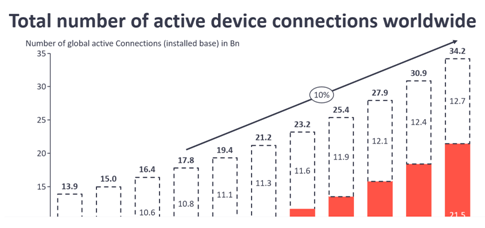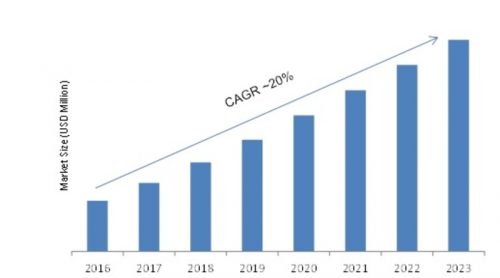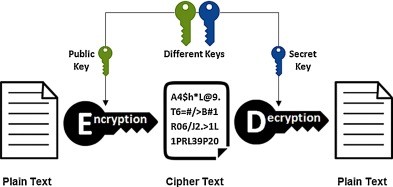IoT Assignment: Effects Of Changing Dynamics Of Smartphone
Question
Task: Discuss the impact of IoT on the dynamics and trends of the smartphones with the help of various secondary sources.
Answer
Abstract
The present IoT assignment has been focused on the implication of the IoT devices on the industry of smartphone manufacturing companies. The impact can be both positive and negative, which influence the working of the companies in this sector. Moreover, the negative impacts of the IoT can be mitigating with the help of proper strategies that has been suggested in the study. The study helps to identify the dynamics of the smartphone industry and the ways by which it can be impacted by the emerging IoT technology.
Chapter 1: Introduction
1.0 Introduction: The Internet of Things (IoT) can be defined in this IoT assignment as a network of intelligent devices that can range from the appliances that are used in home to the equipment that are used for industrial purposes that can be connected to the Internet and monitored along with sharing valuable information from any location in the planet. The most effective use of IoT can be performed with the help of smartphones that has been impacting the trends of these devices on a daily basis. The present study and research has been focused on the effect that IoT might have on the dynamics and trends of the smartphones with the help of various secondary sources.
Thesis Statement: The impact that IoT have on the smartphone industry has been changing the dynamics and trends of the industry in a significant manner.
1.1 Background of the study of IoT assignment: Internet of Things has been one of the most significant topics in the technological industry along with the policies and engineering circles. The incorporation of the IoT devices has been showing a transformation of the aspect of the living of the customers. The internet enabled devices and appliances, along with automation components in home and various energy management decisions, helps people to reach the vision of smart home. The connection in the initial years of the IoT showed that nearly 4% of the people are connected with the help of their devices but the emergence and interpretation of the smartphones and IoT has been resulted in nearly 49% of the population of the world has been connected (Kamilaris and Pitsillides, 2016). Moreover nearly 8.4 billion devices have been connected on a global level which has helped the world to come closer to each other. IoT has been changing the dynamics of the smartphone industry in a significant manner due to which it has been predicted that smartphone industry has a market of 40.9 billion dollars in the year 2020 with proper implication of IoT in the devices (Ng and Wakenshaw, 2017).

Figure 1: Implication of IoT in smartphones
(Source: Ng and Wakenshaw, 2017)
1.2 Aim and Research Objectives of IoT assignment: The objective of the study is to determine the effect of IoT on the changing dynamics of the smartphone industry.
The objectives are as follows:
- To determine the concept of the IoT and the smartphone industry
- To evaluate the dynamics of the smartphone industry
- To investigate the positive and negative impact of IoT on the smartphone industry
- To analyse the methods by which the negative impact of IoT can be eliminated
1.3 Research Questions: The questions are as follows:
- What is the concept of the IoT and the smartphone industry?
- What are the recent dynamics of the smartphone industry?
- What are positive and negative impacts of IoT on the smartphone industry?
- What are the methods by which the negative impact can be eliminated?
1.4 Rationale of the study: Smartphones that are helping people to connect with each other with the help of IoT can be associated with several issues. The IoT has cable people live a smart lives where normal activities on a daily basis can be simplified but the privacy of the people has been compromised. The valuable personal information and data of the people is being misused due to which the complete adoption if IoT can be held back in the smartphone industry. The interconnected nature of the IoT devices has been associated with the issue of privacy and security due to which the incorporation as been dynamically changing in the method of the personal data has been collected, analysed and protected (Paul et al., 2016). Improperly secured devices can also be open vulnerable to cyber attacks and exposing the data of the used for theft. There are several other issues that can be related to IoT that has been discussed in the study to explore the various impacts of IoT that can change the dynamic of smartphone industry.
1.5 Summary: The present section of the IoT assignment has been focused on the various aspects of the research study that lays a background on which the later study will be conducted. The objectives and questions have been framed to explore the various areas of the topic that can be used to enhance the authenticity of the study. The section also provides a background and rationale for the topic to increase the relevance and understandability of the research.
Chapter 2: Literature Review
2.0 Introduction: The present section of the IoT assignment is based on the various aspects of the research topic that has been analysed and evaluated from the secondary sources that are relevant and in the context of the study. The secondary sources have been properly evaluated to explain the aspects of the topic to enhance the relevance of the present research study.
2.1 Concept of the IoT and the smartphone industry: As opined by Perera et al., (2015), IoT is a network is the physical devices, digital machine along the objects the uses software and various sensors that can utilized to form proper connectivity in order to share the information. The thing present in the context of IoT is basically the natural and manmade objects that can be assigned with a unique IP address and help the users to exchange the data as per the certain predetermined rules and regulations. The best tools that can be used in order to properly harness the advantages of IoT solutions are the smartphones. In the present world, there are nearly 2.6 billion smartphones and the analysis of the market trends has been resulting in exponential growth of the users in the coming future. As per the views of Osmonbekov and Johnston, (2018), the reason for the significant impact of the IoT devices on the smartphones industry is due to the fact that the smartphones has simplified our lives. It can be possible with the help of IoT devices to interlinking a myriad of devices and exchange valuable information, which can further help to simplify the lives of people.

Figure 2: Active number of IoT devices on a global level
(Source: Mainzer, 2017)
2.2 Recent dynamics of the smartphone industry: As opined by Mainzer, (2017), from being a product of luxury to product of the basic necessities for daily life activities like movies, shopping and communication the use of smartphones has not been limited to the use only for talking purpose. The adoption of the users of the smartphones has been happening at a rapid pace like 1.4 billion smartphones were sold in the year 2014 which has been growing a rate of 12.2%. In 2018, the selling of smartphones has been enhanced to 1.87 billion devices. However, the increment has fallen to 9.8% in the last few years due to which IoT can be considered as a necessity for the smartphone manufacturing companies to keep demand high. The incorporation of IoT can be considered to be important as the trends have been showing a continuous growth in the newer technologies like that of 5G.

Figure 3: Growth in smartphone sales
(Source: Singh and Singh, 2015)
2.3 The positive and negative impact of IoT on the smartphone industry: According to Singh and Singh, (2015), IoT has the potential to change the trends of smartphone industry in a significant manner. Although there can be several negative effects discussed in this IoT assignment that the technology might have on the industry along with the positive aspects. In order to realize the methods by which IoT may influence the industry of smartphone it can be vital to consider the negative perspective so that these areas can be improved in the future. Both the aspect can be important to consider, the positive impacts of the IoT on the concerned industry are as follows:
Cost Savings- It can help the smartphones to communicate with each other in an efficient manner which can help in conserving and saving the cost and time for the various activities. As observed by Shim et al., (2017), the smartphone manufacturers have been trying to capitalize on this context as it is helping them to integrate the various functions in the smartphones which can enable the users to perform many activities with the help of smartphones.
Information- The information that can be shared with the help of IoT in smartphones can help companies make better decisions by determining the requirements that people might have from the electronic devices. It can also help the people who are using smartphones to gain proper knowledge of the trends and make decision to yield maximum output.
Communication- The prominent impact of IoT on smartphone devices is that it can help the consumers and smartphones to communicate with each other in a significant manner. As suggested by Leitner and Stiefmueller, (2019), transparency among the information can be raised which can further ensure in greater quality and lesser inefficiencies of the smartphone industry.
Automation and control- IoT has been helping the vital players of the smartphone industry to enhance the capability of the machines to communicate with each other without any intervention of the people. As opined by Fernandes et al., (2017), this can help the physical objects to controlled and connected with each other without any wireless infrastructure as it can help to enhance the automation and control of the services of the smartphones.
Increased Productivity- Productivity is the major aspect mentioned in this IoT assignment that can help to enhance the profitability of the smartphone industry. IoT can offer to reduce the mismatch of the services and the requirements of the smartphone manufacturers for the market and therefore increasing the productivity of their organisation.
On the contrary, the negative impact that IoT might have on the smartphone industry can be recognized with the help of evaluation of the following areas:
Losing Security on Privacy- In the context of security issues cannot be new in the relevance of information technology. The characteristics of several IoT incorporation in the prevalent new and unique issue made to the challenges of security have been affecting the business smartphone industry. As said by Poudel, (2016), these challenges can be amplified by any other consideration for instance mass scale deployment of homogenous IoT devices along with the capability of the other devices that can impact the likelihood of the decision to be insecure.
Emerging economies and development issues- The IoT can hold a significant promise in delivering to the social and economical advantages for the emerging and developing economies. The broader scope of the challenges of the IoT is that meeting the standards and requirements of the developing nations along with the developed nations.
Legal, regulatory and Rights- The utilization of the IoT devices can raise many new regulatory and legal issues that can be amplified with the existing legal issues in the aspects of the Internet. According to Gil et al., (2016), the issue of the smartphone industry can be surrounding the cross border data which can collect data of the people that can be transmitted from one jurisdiction to another jurisdiction with the help of various data protection law which can further enhanced the complexities in their services.
Interoperability or standards- A divided environment of the proprietary of IoT can be technical incorporation that can inhibit the value for users and smartphone industry. The complete interoperability across the smartphones and their services cannot be feasible or required which can lead the purchaser to be hesitant to purchase the smartphones as their can chances of inflexibility and complexity in smartphones.
2.4 The methods by which the negative impact can be eliminated within this IoT assignment: The method that can be used by the smartphone users in order to mitigate the negative impacts and the risk that can be associated with the IoT devices are as follows:
Implementing IoT security Analytics- The security issues that can be associated with IoT devices can reduce the incorporation of security analytics. As said by Arnold and Voigt, (2017), this can help in collecting, correlating and evaluation of the data from various sources that can be used to assist IoT security providers for identifying the threats and dealing with the existing issues.
Public Key Infrastructure- The PKI can be the set of policies and methods related to hardware and software which is essential for creating, managing and distributing the digital certificates. As per the views of Zhou and Ding, (2017), the security methods can be improved over the years to be an efficient solution for the IoT related security issues.

Figure 4: Public Key Infrastructure
(Source: Zhou and Ding, 2017)
Securing the communication process and network- The idea of IoT can work on the communication between the connected devices. The communication can be encrypted with the help of AES 256, HTTP and AES 128 which can help in forming a layer of protection which can render the interface to be impregnable to the potential hackers. As per the views of Lu and Cecil, (2016), in order to sustain the smooth operators there is a requirement for the IoT networks to be secured and protected in proper manner with the help of intrusion prevention, firewall and several other techniques.
2.5 Summary
This IoT assignment has been helpful in determining the aim pot that It may have on the smartphone industry. The impact that have describes are based on both positive and negative aspects. Other than that, the methods that can be used to overcome these issues, risks and negative impacts have also been discussed in the study in order to enhance the relevance.
Chapter 3: Methodology
3.0 Introduction: The present section of the study aims to discuss the methods that have been used for the research in order to procure proper and relevant data in order to evaluate and conclude the proper information to enhance the authenticity of the study.
3.1 Research Design: It can be defined as the framework of methods and procedure that can be chosen in order to collect the data in a proper and logical manner. The design of the study can be divided into three categories that are:
- Exploratory,
- Explanatory
- Descriptive
For the present study of IoT assignment, the explanatory design will be best suited as it can help in providing a proper solution the issues that can embed related to the research to change the study to be more genuine and reliable (Dannels, 2018).
3.2 Research Philosophy: It is a collection of nature and development of the knowledge in the relevance of the reach methods. It can be used to develop a belief in the attached that can be used in collection, analysing and interpretation of the information (Kennedy, 2017). Philosophy can be categorized into categories that are:
- Interpretivism
- Positivism.
Interpretivism will be used as it can help to deal with the complex and contextual factors that can be related in the context of the study.
3.3 Research Approach: It involves the data collection and interpretation along with the evaluation that can be helpful in proper researching of learning relate to the idea of the topic of study. Approach again can be divided into three categories that are:
- Inductive
- Deductive
- Abductive.
In the present study of IoT assignment, inductive approach will be used to generate new conclusion as it can help to explore the topic of research in a proper manner (Johnston, 2017).
3.4 Data Collection and analysis technique: In the present research secondary data collection will be used in order to perform thematic analysis of the topic, by developing proper themes that will be relevant for the study (McCusker and Gunaydin, 2015). The contemporary journal and articles will be analysed and succeed from the proper thematic analysis. The above mentioned method of data collection will be useful to provide a proper undressing in the impact of IoT on smartphone industry.
3.5 Sampling Technique and Sample Size: For the present study, non-probability sampling techniques will be used to select the secondary sources as per the requirement as suitable for the topic of study (Palinkas et al., 2015). It can help in selecting the predetermined sources for the conduction of the thematic analysis. Nearly 2 articles and 3 journals will be selected for the study in order to perform proper analysis of the study.
3.6 Ethical Consideration: The collected data will be secured and encrypted with under the legislation of Data Protection Act, 1998, so that the collected data will not be used for any unethical activities and the utilization is only limited to the research study.
3.7 Summary: The section of the study helps to determine the design, approach and philosophy that will be used in the research for any of the data along with sampling techniques and method of data collection that can be most suitable for performing the research in a proper manner.
Chapter 4: Discussion and implications of research
The present IoT assignment has been focused on the impact that it might have on the smartphone industry. The IoT has been one of the most emerging technologies that can influence the life of the common people in a significant manner. The research will help in analysing the significant ways in which IoT has helped improve the performance of Smartphones. The ethical consideration can be necessary as it can help in providing proper information about the technology, which can further impact the mindset of the readers. The IoT has several negative impacts on the smartphone industry but if they are properly mitigated and dealt with then it can change the lives of the people in a significant manner. It can be believed that the competition in the segment of smartphone industry will continue to be exhibited in a significant manner, which can enable the leading manufacturers to innovate with help of IoT in order to protect the market share and try to the leader in the context of revenue and market share.
Chapter 5: Conclusion
From the above study of IoT assignment, it can be concluded that IoT has one of the most disruptive innovative technologies as it had the potential to impact the life of the people. In order to overcome the existing issues in the IoT devices the encryption needs to be strong along with the proper methods have been suggested in the literature review of the study. Other than, the issues have been identified in the introduction part along with the dynamics that are existent in the smartphones industry. The demands of the smartphones can be further raised if the IoT are properly implemented in the smartphones. The use and implication of IoT in the smartphone has been imminent and which can make the life of the users to be very simple as it can help in easing the daily life activities. The study helps to provide a clear aspect of the impacts that are both positive and negative and the methods by which the negative impacts can be reduced.
Reference List
Arnold, C. and Voigt, K.I., 2017. Ecosystem Effects of the Industrial Internet of Things on Manufacturing Companies. Acta Infologica, 1(2), pp.99-108.
Dannels, S.A., 2018. Research design. In The reviewer’s guide to quantitative methods in the social sciences (pp. 414-428). Routledge.
Fernandes, E., Rahmati, A., Eykholt, K. and Prakash, A., 2017. Internet of things security research: A rehash of old ideas or new intellectual challenges?. IEEE Security & Privacy, 15(4), pp.79-84.
Gil, D., Ferrández, A., Mora-Mora, H. and Peral, J., 2016. Internet of things: A review of surveys based on context aware intelligent services. Sensors, 16(7), p.1069.
Johnston, M.P., 2017. Secondary data analysis: A method of which the time has come. Qualitative and quantitative methods in libraries, 3(3), pp.619-626.
Kamilaris, A. and Pitsillides, A., 2016. IoT assignment Mobile phone computing and the internet of things: A survey. IEEE Internet of Things Journal, 3(6), pp.885-898.
Kennedy, A.M., 2017. Macro-social marketing research: philosophy, methodology and methods. Journal of Macromarketing, 37(4), pp.347-355.
Leitner, C. and Stiefmueller, C.M., 2019. Disruptive Technologies and the Public Sector: The Changing Dynamics of Governance. In Public Service Excellence in the 21st Century (pp. 237-274). Palgrave Macmillan, Singapore.
Lu, Y. and Cecil, J., 2016. An Internet of Things (IoT)-based collaborative framework for advanced manufacturing. The International Journal of Advanced Manufacturing Technology, 84(5-8), pp.1141-1152.
Mainzer, K., 2017. From Augmented Reality to the Internet of Things: Paradigm Shifts in Digital Innovation Dynamics. AUGMENTED REALITY, p.25.
McCusker, K. and Gunaydin, S., 2015. Research using qualitative, quantitative or mixed methods and choice based on the research. Perfusion, 30(7), pp.537-542.
Ng, I.C. and Wakenshaw, S.Y., 2017. The Internet-of-Things: Review and research directions. International Journal of Research in Marketing, 34(1), pp.3-21.
Osmonbekov, T. and Johnston, W.J., 2018. Adoption of the Internet of Things technologies in business procurement: impact on organizational buying behavior. Journal of Business & Industrial Marketing, 33(6), pp.781-791.
Palinkas, L.A., Horwitz, S.M., Green, C.A., Wisdom, J.P., Duan, N. and Hoagwood, K., 2015. Purposeful sampling for qualitative data collection and analysis in mixed method implementation
Paul, A., Ahmad, A., Rathore, M.M. and Jabbar, S., 2016. Smartbuddy: defining human behaviors using big data analytics in social internet of things. IEEE Wireless communications, 23(5), pp.68-74.
Perera, C., Liu, C.H. and Jayawardena, S., 2015. IoT assignment The emerging internet of things marketplace from an industrial perspective: A survey. IEEE Transactions on Emerging Topics in Computing, 3(4), pp.585-598.
Poudel, S., 2016. Internet of things: underlying technologies, interoperability, and threats to privacy and security. Berkeley Tech. LJ, 31, p.997.
Rong, K., Hu, G., Lin, Y., Shi, Y. and Guo, L., 2015. Understanding business ecosystem using a 6C framework in Internet-of-Things-based sectors. International Journal of Production Economics, 159, pp.41-55.
Shim, J.P., Avital, M., Dennis, A., Sheng, O., Rossi, M., Sorensen, C. and French, A., 2017. Internet of things: Opportunities and challenges to business, society, and is research.
Singh, S. and Singh, N., 2015, October. Internet of Things (IoT): Security challenges, business opportunities & reference architecture for E-commerce. In 2015 International Conference on Green Computing and Internet of Things (ICGCIoT) (pp. 1577-1581). IEEE.
Zhou, C. and Ding, L.Y., 2017. Safety barrier warning system for underground construction sites using Internet-of-Things technologies. Automation in Construction, 83, pp.372-389.












